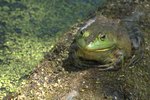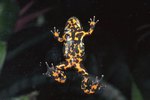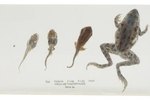
The yellow-spotted salamander (Ambystoma maculatum) lives in forests throughout eastern North America. Although they are widespread in this region, these amphibians are seldom seen out and about. Yellow-spots prefer their privacy as they live out their lives in moist, dark areas just beneath the feet of hikers and nature lovers.
Geographic Location
The yellow-spotted salamander ranges from Maine to Texas in the United States and from Newfoundland and Labrador to Ontario in Canada. The species has not been found south of the United States, but they've been found well north of the great lakes, in Quebec, and in Newfoundland in Canada. They live in every state of the eastern United States except Florida.
Forest Habitat
The yellow-spotted salamander lives in deciduous forests with ponds nearby. They prefer low-lying forests near flood plains over habitats higher in elevation or in mountainous areas. Salamanders require a good deal of moisture in their environment because their skin has to be kept damp. Adult salamanders live on the forest floor, but need ponds for reproduction. Yellow-spots living in areas where winters bring freezing temperatures will hibernate until spring thaw. They pass the winter in burrows or other areas where they can keep their bodies from freezing, such as wood or stone piles.
Living Quarters
Within the forest, yellow-spotted salamanders live in burrows underground, under logs and beneath stones. They often take up residence in other animals' abandoned burrows, such as those made by moles. Adult salamanders keep to within a few yards of their home throughout their lives. However, they will travel up to one-third of a mile to a suitable breeding pond. They live alone, and rarely venture outside their homes. During a rain or just after rainfall, yellow-spotted salamanders are more likely to go out in search of food. They primarily forage at night, hunting in the leaf debris on the forest floor. Yellow-spots are carnivores that eat worms, spiders, insects, slugs and other invertebrates.
Habitat for Reproduction
Beginning in early spring, yellow-spotted salamanders look for small ponds in which to lay their eggs. Once she selects a pond, a salamander will visit the same pond for breeding for the rest of her life. The ponds can be permanent or temporary pools, and may still be partially frozen when the salamanders congregate there to mate. The salamanders prefer newly formed pools, because few predators will be present to eat the eggs. After breeding, the female salamander lays a cluster of eggs on underwater plants. After the eggs have gestated for four to eight weeks, they emerge as larvae. The salamander larvae stay in the pond and eat aquatic insects. After nine to 15 weeks in the larval stage, they develop into small salamanders. They then emerge from the pond and live on land.
References
- University of Guelph: Yellow Spotted Salamander, Ambystoma maculatum -- Distribution
- University of Guelph: Yellow Spotted Salamander, Ambystoma maculatum -- Ecology
- University of Guelph: Yellow Spotted Salamander, Ambystoma maculatum -- Behaviour
- University of Guelph: Yellow Spotted Salamander, Ambystoma maculatum -- Reproduction
- Ontario Nature: Spotted Salamander (Ambystoma maculatum)
- Nova Scotia Museum: Yellow-Spotted Salamander
- National Geographic: Spotted Salamander
Resources
Photo Credits
-
Jupiterimages/Photos.com/Getty Images
Writer Bio
Madeline Masters works as a dog walker and professional writer. In the past she has worked as a fitness columnist, fundraising copywriter and news reporter. Masters won two Pennsylvania Newspaper Association Awards in 2009. She graduated from Elizabethtown College with a Bachelor of Arts in English.




